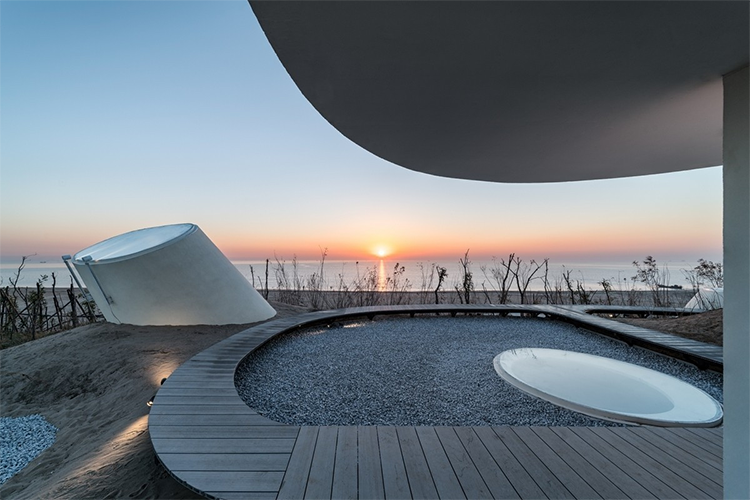China Art Travel: UCCA Dune Museum — A Seaside Contemporary Art Escape
Standing on the soft sand dunes of Beidaihe’s golden coast, the salty sea breeze carries a quiet seaside hush. Nestled between the dunes like a carved cave is the UCCA Dune Museum, a secluded seaside retreat where contemporary art and coastal ecology converge. The designers used concrete and shifting light to weave a poetic narrative of retreat: the building itself is a work of art, and every step into its galleries feels like exploring the sculpted interior of a dune.
1. Architecture: an artistic vessel in harmony with nature
Opened in 2018 and designed by the renowned OPEN Architecture studio, the UCCA Dune Museum draws inspiration from the organic shapes of sand dunes. Its exterior presents irregular, flowing lines as if shaped by wind and waves. Inside, 930 square meters are arranged as seven cave-like galleries of varying sizes, linked by winding paths that guide visitors through alternating light and shadow. Skylights and narrow slits invite natural light to play across the raw concrete surfaces, casting ever-changing shadows that create a subtle dialogue between artwork, space, and time. More than an exhibition venue, the museum is a piece of land art and was named among China’s most design-forward museums.
2. Exhibitions: a coastal laboratory for contemporary art
As a branch of UCCA (Ullens Center for Contemporary Art), the Dune Museum focuses on cutting-edge contemporary exhibitions, drawing around 100,000 visitors annually. Permanent and temporary shows typically explore the relationship between nature and culture. Past projects, such as “Rearview Landscapes,” used installation and video to investigate coastal ecological change. The works often take an experimental approach—new media, sculpture, and cross-disciplinary pieces—many of which are site-specific: wind-activated sound installations or mirrored sculptures that catch and reflect sunlight.
Must-see experiences:
– “Cave Light” golden hour: from about 3 PM until sunset, slanted sunlight pours into the central gallery in dramatic beams, reminiscent of a sacred space.
– Hidden photo spot: the outdoor terrace by the café offers panoramic views of dune and sea—sunrise is especially magical.

3. Practical guide: tickets, timing, and visiting tips
Opening hours and tickets:
– Peak season (May–October): 9:30–17:00; off-season closing may be 16:30. The museum is typically closed on Mondays except public holidays.
– Tickets: usually ¥60–¥100; special exhibitions may require an additional ticket. Payment by WeChat Pay or Alipay is widely accepted; international credit cards can be unreliable, so bring cash if possible.
Transport and nearby attractions:
– By car from Beijing: about a 3-hour drive. By high-speed train: arrive at Qinhuangdao, then a 40-minute taxi ride to the museum. The museum sits inside the Aranya community—close to the iconic ‘Library of the Lonely’ and the seaside auditorium, both popular photo spots.
– Recommended route: morning at the museum → lunch at the museum café with sea views → afternoon stroll among the community’s outdoor installations.
Practical tips:
– Museum Wi‑Fi covers indoor areas, but dune-top signals are weaker. Lockers and a baby-care room are available; ramps make the site wheelchair accessible.
– To avoid crowds, skip weekend afternoons—early morning or the last hour before close offers the quietest experience.
4. Why it’s worth a dedicated trip
UCCA Dune Museum redefines the museum visit: it is both an artistic container and a medium for sensing the natural world. When your fingertips brush the textured concrete and sea wind moves through a gallery as you view an artwork, you feel the architecture, art, and environment coexisting. The museum appeals to travelers seeking niche cultural experiences, photographers after dramatic light and landscape shots, and anyone yearning for a peaceful escape. Before you leave, sit on the dune and watch sunset drape the museum in gold—at that moment, art and nature are indistinguishable.



